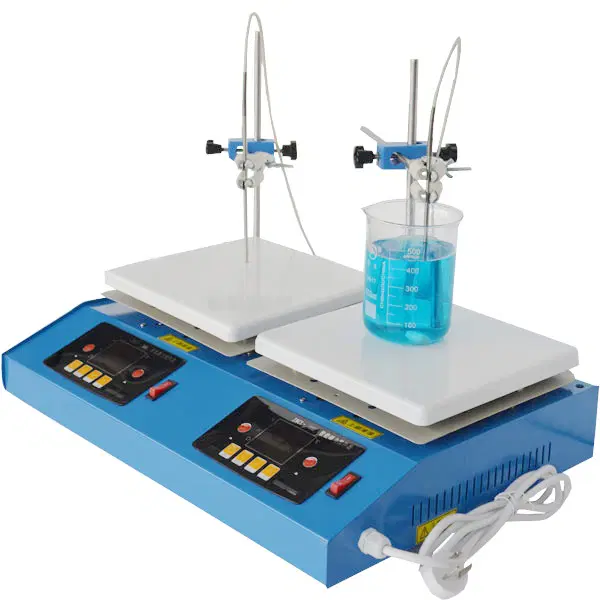Heating plates are essential devices in modern laboratories, designed to provide heat uniformly and controllably. Their design varies depending on the application, but generally, they consist of a flat, heat-resistant surface, usually made of materials like ceramic or aluminum, which ensures even heat distribution. The base of the device contains the heating elements and the electronic controls necessary to adjust the temperature precisely.
The ergonomic design of heating plates facilitates their use in laboratory environments. The heating surfaces are often coated with chemical-resistant materials, prolonging their lifespan and ensuring user safety. Additionally, many modern models incorporate digital displays that show real-time temperature, allowing for precise adjustments and enhancing clinical outcomes.
Functionality and Performance of Heating Plates
The performance of a heating plate is measured by its ability to reach and maintain precise temperatures over extended periods. Modern heating plates use advanced heating elements that allow for rapid temperature rise and uniform heat distribution. This is crucial for applications requiring thermal stability and diagnostic precision.
Temperature controls are typically digital, enabling fine and precise adjustments. High-end models can reach temperatures up to 500 degrees Celsius and maintain them with minimal fluctuations. This ability to maintain stable temperatures significantly improves clinical outcomes by reducing variability in experiments and tests.
Clinical Applications of Heating Plates
Heating plates are used in a wide variety of clinical and research applications. In the clinical field, they are employed for sample preparation, where precise temperature control is crucial for reliable results. For example, in blood analysis, thermal uniformity ensures that samples are kept at the appropriate temperature, improving diagnostic precision.
In research, heating plates are used for processes such as solvent evaporation, culture incubation, and reagent preparation. The ability to maintain constant and controlled temperatures allows researchers to perform repeatable experiments and obtain reliable data, which is essential for scientific advancement and improved clinical outcomes.
Safety and Maintenance of Heating Plates
Safety is a primary concern in the design of heating plates. Modern models include various safety features, such as automatic shutoff, overheating protection, and cool-to-touch surfaces. These measures ensure that users can operate the equipment without the risk of burns or accidents, enhancing laboratory efficiency and safety.
Maintaining heating plates is relatively simple, thanks to their chemical-resistant and dirt-resistant surfaces. Regularly cleaning the heating surface and checking the controls and electrical cables to ensure the device operates correctly is recommended. Proper maintenance prolongs the equipment’s lifespan and ensures it continues to provide diagnostic precision.
Comparison of Heating Plate Models
There are various models of heating plates on the market, each with specific features suited to different needs. For example, ceramic heating plates are often preferred for their high chemical resistance and ability to reach high temperatures. On the other hand, aluminum ones are valued for their rapid thermal conductivity and lower cost.
Comparing models involves evaluating aspects such as temperature range, heating uniformity, safety features, and temperature controls. Users must consider which features are most important for their specific applications, as this will directly influence clinical outcomes and diagnostic precision.
Recent Innovations in Heating Plates
The technology of heating plates has advanced significantly in recent years. Innovations include developing more resistant and heat-conductive materials and integrating digital controls and wireless connectivity. These advancements allow for more precise temperature control and facilitate remote monitoring of the equipment.
Additionally, some heating plates now come equipped with intelligent sensors that automatically adjust the temperature to maintain optimal conditions, which is crucial for applications requiring high precision. These innovations not only improve laboratory efficiency but also contribute to improved clinical outcomes and more accurate diagnostics.
Conclusion
Heating plates are an indispensable tool in the modern laboratory, offering precision and control in a wide range of applications. From their design and construction to their performance and safety, every aspect of these devices is optimized to improve clinical outcomes and diagnostic precision. Recent innovations continue to expand their capabilities, ensuring they remain a key component in research and clinical diagnostics.
Choosing the right heating plate depends on the specific needs of each laboratory, but with the wide variety of models available, it is possible to find an option that perfectly suits any application. With their ability to provide precise and controlled temperatures, heating plates are essential for ensuring quality and reliability in laboratory results.
We understand that you need equipment that delivers maximum value to your laboratory. We invite you to visit https://kalstein.de/category-product/laboratory-line/hotplates-and-hotplate-stirrers/, to immerse yourself in our universe of cutting-edge technology equipment. Our prices are competitive and accessible, we combine the convenience of online shopping with the guarantee of an exceptional product. Because you deserve the best, we create and offer top-tier laboratory equipment. Make your choice today, where science comes to life. https://kalstein.de/

